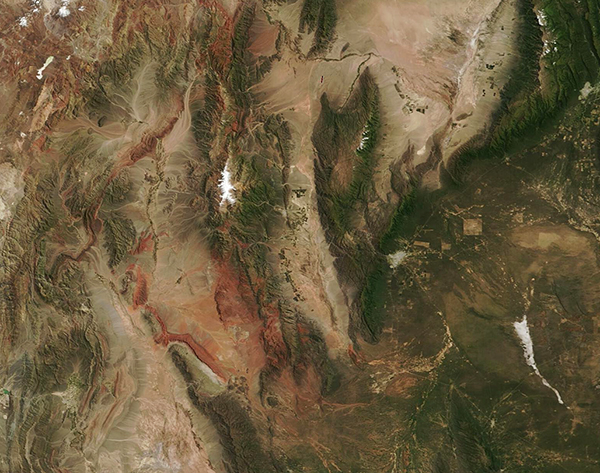Images
March 3, 2023 - Talampaya National Park and Ischigualasto Provincial Park
Tweet
On February 28, 2023, the Moderate Resolution Imaging Spectroradiometer (MODIS) on board NASA’s Terra satellite acquired a true-color image of a rugged, red-stained region that appeared positively prehistoric. While the image is, in fact, modern and located in the dry mountains region of northwest Argentina, the land was once the home of dinosaurs. Today, two parks in the area—The Talampaya National Park and Ischigualasto Provincial Park—provide the most complete continental fossil record known from the Triassic Period (245-208 million years ago). As a pair, they were inscribed as a UNESCO World Heritage site in 2000.
Both parks sit in the lower left quarter of the image. Just south and west of a patch of bright white valley fog, distinct rusty-red soils marks Talampaya National Park. Talampaya is famous for its spectacular 600- feet (200 meter) tall red sandstone cliffs and 1,500 year-old petroglyphs. Rock formations tickle the imagination of the modern visitors permitted in the park, particularly a formation that resembles a turtle. Ironically—or appropriately—one of the oldest fossilized turtle remains were found in Talampaya. Named Palaeochersis talampayensis, the turtle measured about 23.6 inches (60 cm) long and has been dated to have lived between 210 and 220 million years ago, in the Late Triassic.
An especially striking, wide, brick-red area which stretches from the northwest to the southeast marks the southwestern boundary of Talampaya National Park, which butts up against Ischigualasto Provincial Park. From space, Ischigulasto Park appears quite different than Talampaya as a light-colored area surrounded by a pale green wash. From the ground, the landscape is arid, rock-strewn, and otherworldly, earning it the nickname Valle de la Luna (Valley of the Moon). Petroglyphs, cave shelters, and tool building sites have all been found in this area. Radio-carbon dating suggests that humans likely inhabited this area between 2,590 – 950 years ago.
Image Facts
Satellite:
Terra
Date Acquired: 2/28/2023
Resolutions:
1km (205 KB), 500m (549.9 KB), 250m (1 MB)
Bands Used: 1,4,3
Image Credit:
MODIS Land Rapid Response Team, NASA GSFC
Tweet
On February 28, 2023, the Moderate Resolution Imaging Spectroradiometer (MODIS) on board NASA’s Terra satellite acquired a true-color image of a rugged, red-stained region that appeared positively prehistoric. While the image is, in fact, modern and located in the dry mountains region of northwest Argentina, the land was once the home of dinosaurs. Today, two parks in the area—The Talampaya National Park and Ischigualasto Provincial Park—provide the most complete continental fossil record known from the Triassic Period (245-208 million years ago). As a pair, they were inscribed as a UNESCO World Heritage site in 2000.
Both parks sit in the lower left quarter of the image. Just south and west of a patch of bright white valley fog, distinct rusty-red soils marks Talampaya National Park. Talampaya is famous for its spectacular 600- feet (200 meter) tall red sandstone cliffs and 1,500 year-old petroglyphs. Rock formations tickle the imagination of the modern visitors permitted in the park, particularly a formation that resembles a turtle. Ironically—or appropriately—one of the oldest fossilized turtle remains were found in Talampaya. Named Palaeochersis talampayensis, the turtle measured about 23.6 inches (60 cm) long and has been dated to have lived between 210 and 220 million years ago, in the Late Triassic.
An especially striking, wide, brick-red area which stretches from the northwest to the southeast marks the southwestern boundary of Talampaya National Park, which butts up against Ischigualasto Provincial Park. From space, Ischigulasto Park appears quite different than Talampaya as a light-colored area surrounded by a pale green wash. From the ground, the landscape is arid, rock-strewn, and otherworldly, earning it the nickname Valle de la Luna (Valley of the Moon). Petroglyphs, cave shelters, and tool building sites have all been found in this area. Radio-carbon dating suggests that humans likely inhabited this area between 2,590 – 950 years ago.
Image Facts
Satellite:
Terra
Date Acquired: 2/28/2023
Resolutions:
1km (205 KB), 500m (549.9 KB), 250m (1 MB)
Bands Used: 1,4,3
Image Credit:
MODIS Land Rapid Response Team, NASA GSFC




